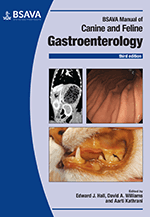
Full text loading...

The major clinical manifestations of chronic small intestinal disease, namely diarrhoea, vomiting and weight loss, reflect perturbations in the digestive and absorptive function of the small intestine and its resident bacterial population. This chapter considers a variety of infectious diseases and chronic enteropathies.
Small intestine: chronic disease, Page 1 of 1
< Previous page | Next page > /docserver/preview/fulltext/10.22233/9781910443361-3e/BSAVA_Manual_Gastroenterology_3_9781910443361-3e.34c.213-223-1.gif

Full text loading...




